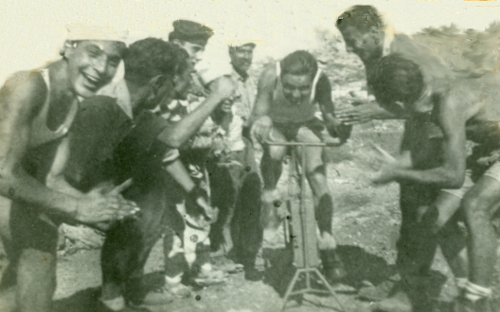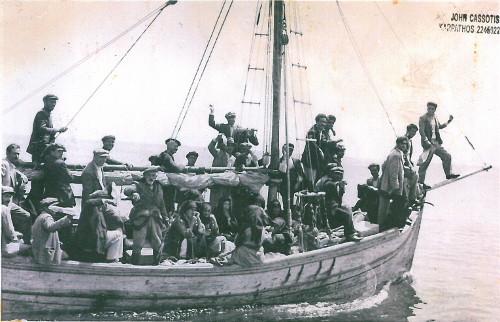The Tristomo Italians
Story told by Nicolas V Hapsis
 It was May 1940 when the locals left Tristomo. The only ones who stayed were our family. We were the last remaining residents of Tristomo. Everyone else left because they had houses elsewhere. For example, Dargakis had a house in Horio, Avlona. They were all shepherds so they went to their stockyards. Gioutlos and Karellas in Saria, Dargakis in Sikias’ Pioli, Fountes with a house here in Diafani. We were the only ones with nowhere else to go. We owned the local coffee shop for years, serving coffee, ouzo. Most of our customers were sponge fishermen, so from August, Tristomo was full of sponge fishing boats. There were small and big sponge fishing caïques from Kalymnos, Halki and Symi and the fishermen all came to our café for drinks and we made a good living, including my mother who worked there as well. These were good times.
It was May 1940 when the locals left Tristomo. The only ones who stayed were our family. We were the last remaining residents of Tristomo. Everyone else left because they had houses elsewhere. For example, Dargakis had a house in Horio, Avlona. They were all shepherds so they went to their stockyards. Gioutlos and Karellas in Saria, Dargakis in Sikias’ Pioli, Fountes with a house here in Diafani. We were the only ones with nowhere else to go. We owned the local coffee shop for years, serving coffee, ouzo. Most of our customers were sponge fishermen, so from August, Tristomo was full of sponge fishing boats. There were small and big sponge fishing caïques from Kalymnos, Halki and Symi and the fishermen all came to our café for drinks and we made a good living, including my mother who worked there as well. These were good times.

During the war the Italians weren’t mean. They were all from small villages, farming people. They didn’t want the war, didn’t want Mussolini who sent them off on these adventures. They made their own smallholdings so they could grow vegetables. They had a smallholding in Diafani and a big one in Olympos. They even used their own excrement!! They collected it, watered it, then threw it on their vegetables. Their cabbages were impressive!!
I remember something Giannis Konsolas told me “One day the Italians tricked me into eating cat!!”
He happened to need them for something and they said “Mister Giannis, today we have excellent food. Hare with macaroni. You should stay and eat with us.”
So, he sits down with them and they all eat. Imagine this delicious food!! Such hard times and they were eating macaroni with hare!!
After they had all eaten and drunk they asked him “Signor Giovanni, sai che cosa mangiato? (What do you think you ate?)”
He answers “Lepre (Hare).”
They tell him “Non lepre. Gatto (Not hare. Cat).”
He couldn’t believe it so they brought him the head and the skin. Konsolas used to tell us that he was vomiting for hours. They kept saying “But why? You enjoyed eating it so it doesn’t matter if it was cat or dog.” They do eat cats and they used to say they ate snakes but only the rear half. And frogs’ legs. And turtles.
They didn’t commandeer our coffee shop. They commandeered Fountes’ house and lived in it. At Zervos’ field they built barracks. They used Dargakis’ oven because it was the biggest as he had a large family and no one else could use it. They had a soldier who was their baker. I remember his breads, they were excellent. So, the Italians settled here and we had no customers. They would not use the café and everyone else was gone!!
 There were about a thousand Italians in Tristomo, soldiers and marines, commanded by a major. They had eight to ten motor torpedo boats and two ships, Camolia and Orsini. Camolia was moored close to our mill. On one occasion a very strong westerly wind blew and Orsini got grounded under Dargakis’ house. Three motor torpedo boats tried to tow her off but she was stuck firm. Then two scuba divers came and dug underneath it and the motor torpedo boats tried again and freed it. I remember 4 motor torpedo boats left one day and only two returned.
There were about a thousand Italians in Tristomo, soldiers and marines, commanded by a major. They had eight to ten motor torpedo boats and two ships, Camolia and Orsini. Camolia was moored close to our mill. On one occasion a very strong westerly wind blew and Orsini got grounded under Dargakis’ house. Three motor torpedo boats tried to tow her off but she was stuck firm. Then two scuba divers came and dug underneath it and the motor torpedo boats tried again and freed it. I remember 4 motor torpedo boats left one day and only two returned.
 NOTE: This probably refers to an action on September 4th 1940. A powerful British squadron consisting of the cruiser Sydney and four destroyers bombarded Karpathos airport and caused extensive damage and many casualties. Five motor torpedo boats sailed from Tristomo to engage the Allied squadron. The cruiser had a small hydro plane that scouted for the motor torpedo boats and the destroyer Ilex was sent against them and as soon as they were in the strait between Karpathos and Kassos, Ilex hit them, sank two and damaged a third. The remaining motor torpedo boats returned to Tristomo and five bombers were sent from Rhodes to bomb the Allied vessels but they failed to hit them.
NOTE: This probably refers to an action on September 4th 1940. A powerful British squadron consisting of the cruiser Sydney and four destroyers bombarded Karpathos airport and caused extensive damage and many casualties. Five motor torpedo boats sailed from Tristomo to engage the Allied squadron. The cruiser had a small hydro plane that scouted for the motor torpedo boats and the destroyer Ilex was sent against them and as soon as they were in the strait between Karpathos and Kassos, Ilex hit them, sank two and damaged a third. The remaining motor torpedo boats returned to Tristomo and five bombers were sent from Rhodes to bomb the Allied vessels but they failed to hit them.
The soldiers were provided with water from Xetrehameno. They had a pump and a tank and they piped the water from there to the tank. They had a repair team with a mechanic in charge. On Koutsoura hill they had a sentry box. They used explosives to dig an underground chamber. It’s still there. And the pillboxes. You can see Saria and the surroundings from there.
Nikolas Filippakis was the waterman for the Italian army. He carried water on a grey mule to Koutsoura, to Ayii Anargyri in Achae where they had an outpost and another in Puntes where they had pillboxes. He had some small barrels and filled them with water and took them to all the outposts. He also acted as their butcher and provided them with meat. The Italians served him with food in a dixie and I have this picture in my mind of him, using a big wooden spoon as a tablespoon spooning spaghetti and lentils out of his dixie, with his huge moustache!!
The Italians’ supplies were provided via the caïque Olga that belonged to George Protopapas. They had commandeered his ship so he brought them supplies from Pigadia and he often brought people as well. George ran the service with his children.

In Tristomo I was among Italians every day and learned the language, not only to speak but to write also. I got on well with the Italian troops because I was young and there were no other children in Tristomo and they all liked me!! They stayed at Zervos’ house and I helped them with cooking. They taught me how to cook pasta and meatballs. The kitchen was where Orfanos’ home is.